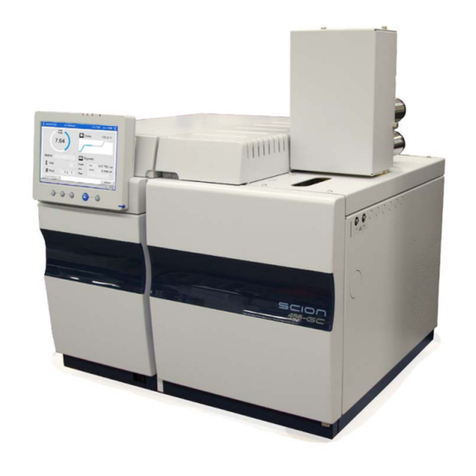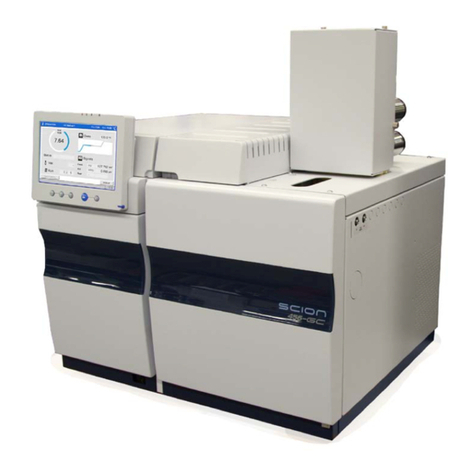
Scion Instruments
Scion Instruments Greenhouse Gases Analyzer Reference Manual Page: 7
TUNING OF THE TCD/FID CHANNEL
•Use Helium as carrier and Nitrogen as make-up gas.
•Turn of all FID flows. Switch V1 to the inject position and set the front EFC-
24 to give a flow of 20 ml/min, measured at the outlet of the FID.
•Switch V1 back to the fill+backflush position and adjust the aux front EFC-
24 to give a flow of 20 ml/min, again measured at the outlet of the FID.
•Measure the flow at vent 1 and adjust the needle valve to give a flow of 20
ml/min.
•Set the front DEFC-14 reference to give 20ml/min out of the reference of
the TCD, and set the DEFC-11 to give 10 ml/min make-up, 30 ml/min
Hydrogen en 300 ml/min Air.
•The front DEFC-14 make-up is used as sample line purge gas.
•Program the system as described in the Operation section of this manual.
Tuning the backflush
Determine the backflush time with a sample containing CO2and CH4.
Initially run the sample with a backflush time of 5.0 minutes.
Reduce this backflush time until the CO2recovery starts decreasing. Set
the backflush to allow full recovery of CO2and CH4.
The signal disturbance due to the valve switching should not influence
both peaks.
Note that CO2is analyzed on the TCD and Methane is analyzed on the FID.
A representative chromatogram of the TCD channel for an injection of lab
air containing ±385 ppm CO2and ±1775ppb CH4is shown in figure 2. The
FID channel is shown in figure 3.
98.587.576.565.554.543.532.521.510.5
45,000
40,000
35,000
30,000
25,000
20,000
15,000
10,000
5,000
0
-5,000
CO2
RT [min]
GC1002B032_Greenhouse_3_19_2010 8_53_44 AM_1_20.DATA [Front (TCD)]
µV
Figure 2: Example chromatogram for the TCD channel of the Greenhouse analyzer





























